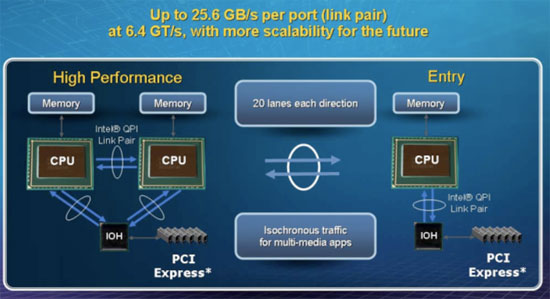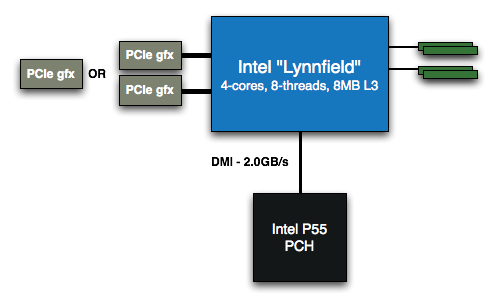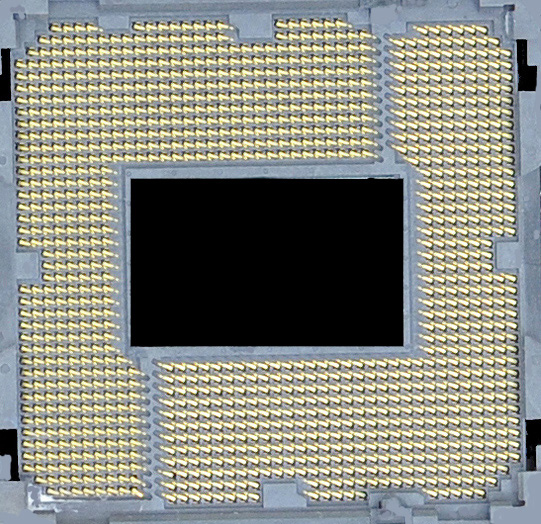The Lynnfield Preview: Rumblings of Revenge
by Anand Lal Shimpi on May 29, 2009 1:00 PM EST- Posted in
- CPUs
Making Nehalem Affordable: LGA-1156
Take the Core i7, shave off one memory controller and replace the high bandwidth QPI link with Intel’s slower DMI and you’ve got the makings of a (more) mainstream Nehalem.
Many have been calling this processor the Core i5 although I’m not quite ready to jump on that bandwagon, so I’ll keep referring to it by its socket (LGA-1156) or codename (Lynnfield).
Intel’s QPI is a very fast bus delivering up to 25.6GB/s of bandwidth. The image below shows you how Intel sees it being useful:

If you’ve got a multi-socket system (e.g. dual processor Xeon workstation, or Skulltrail successor) or if you’ve got a lot of high bandwidth PCIe devices (e.g. multi-GPU or lots of Larrabees) then QPI makes a whole lot of sense. However, if you’ve got a single socket system and aren’t running a lot of high bandwidth PCIe devices then QPI is overkill.
Intel’s DMI is the link used between the X58 chipset and the ICH10 I/O controller, it’s a much more conservative bus capable of delivering 2 - 4GB/s of bandwidth. That’s enough bandwidth for things like SATA and USB but a single PCIe x16 slot can deliver 16GB/s of bandwidth, far too much for Intel’s DMI.
Instead of crippling graphics on its mainstream platform, Intel did the next best thing and integrated 16 PCIe 2.0 lanes onto the die of its mainstream Nehalem part.
What you get looks like this:

A Lynnfield system only need two chips (CPU + PCH) while a Bloomfield system needs three (CPU + IOH + ICH)
The 16 PCIe 2.0 lanes can be configured as one x16 or two x8, allowing you enough bandwidth and very low latency to do things like CrossFire or SLI. Any additional PCIe lanes will branch off of what Intel is now calling the Platform Controller Hub (PCH). The first PCH is Intel’s P55 chipset; all you need is a Lynnfield CPU and the P55 PCH, no additional ICH is necessary as all of that functionality is embedded in the PCH.
The price of Intel’s P55 PCH is also much lower than the X58 chipset, in fact P55 is expected to be price competitive with P45 + ICH10. In other words, we should eventually see P55 boards priced at $100 or less.
Getting rid of QPI and one of the three DDR3 channels knocked down the pin-count of LGA-1366, but adding in 16 PCIe 2.0 lanes brought it back up to 1156 which you can count in the socket below:

I’ve blacked out the motherboard around it and the caps in the middle to protect the innocent.










95 Comments
View All Comments
Jabbernyx - Monday, June 1, 2009 - link
You're forgetting the $10 off promo code and 5% Live cashback ;)Randomblame - Friday, May 29, 2009 - link
Anyone else irritated that when this launches intel will have 5 sockets going?Shall we count em?
lga 775 core 2
lga 1366 i7
lga 1160 lynfield
lga 771 xeon penryn
lga 611 itanium
Did I miss any?
Anonymous Freak - Sunday, May 31, 2009 - link
If you're going to include Itanium; you might as well include the mobile sockets as well.Last October, Intel had one desktop, three server, and two mobile sockets:
LGA775 on the desktop was it.
LGA771 for dual Xeon, PGA-604 for quad-plus Xeon. (And LGA775 for single-socket servers, where the processors were just Core 2 series processors slapped with a "Xeon" name on them, so I'm keeping that with 'desktop'.) PAC-611 is Itanium.
Socket M is the slightly older mobile socket, Socket P is the newer. One could say that Socket M was already dead in October.
Early next year, we will have three desktop, two server, and two mobile sockets.
LGA 775 will be the low-end Core 2 socket, LGA 1366 for i7, and LGA 1156 for Lynnfield. Lynnfield should overtake Core 2 very quickly, especially after the integrated-graphics chips come out, and drop to two desktop sockets, though.
LGA 1366 doubles as the single and dual server socket; and the new "Nehalem EX" will in all likelihood have a new socket shared with the new Itanium (from reasonable guesses, anyway.)
Mobile will have just Socket P until the mobile Nehalems launch, when a new mobile Nehalem socket will be out.
Sorry, but LGA 771 is already dead. Its processors are completely obsolete at this point, by Nehalem-EP. And PGA-604 (which you missed,) as well as PAC-611, will be obsoleted by the Nehalem-EX socket. (Again, just guessing. The entire point of QPI was to make Xeon and Itanium share resources, so I would imagine they would use the same socket. Especially with Xeons now at higher power draw than even the highest draw Itanium; there is no reason for Itanium's goofy socket-with-power-pod arrangement any more.
Drazick - Friday, May 29, 2009 - link
Though the system looks good.I really liked the one chip Idea (Chipset).
I hope Intel eventually let nVidia develop chipsets for this platform.
Why don't you think the regular PCIE X16 lane in this system is enough for GPGPU? It might not be the best but for Encoding some movies and Accelerating Matlab it should be enough, no?
Anand Lal Shimpi - Saturday, May 30, 2009 - link
I didn't mean to imply that 16 PCIe 2.0 lanes aren't enough for GPGPU. But if you're doing a *lot* of compute over the PCIe bus, perhaps over multiple very high end GPUs, then you'll probably want QPI. This is more of a HPC or head-in-the-clouds-desktop scenario though.It should be more than enough for GPU based video encode or math.
Take care,
Anand
ssj4Gogeta - Friday, May 29, 2009 - link
Even if Intel allows Nvidia, they can't make integrated graphics for i5 because the chip is connected to the chipset via 2 GB/s DMI, which will bottleneck it.Doormat - Friday, May 29, 2009 - link
Until the price of 4GB DDR3 sticks come down (and I could put 16GB of RAM on the board), I think the i7 is where its at. At least with i7, I can go with 12GB now and then upgrade to 24GB later (12GB I need, 24GB I don't know...).A5 - Friday, May 29, 2009 - link
If you NEED 12GB, then Lynnfield isn't going to be for you. Intel would much rather you use Xeons for that kind of workload anyway :Pltcommanderdata - Friday, May 29, 2009 - link
So with mainstream Nehalems not having any QPI links and high-end Nehalems with QPI not needing them, are third-party IGPs dead? It seems that even if nVidia can win their legal issues with Intel, the technical challenges of being limited to DMI seem to make the Intel chipset business unprofitable. Higher priced chipsets with IGPs would be bandwidth limited over DMI and just making southbridges doesn't seem very glamourous or profitable.Anand Lal Shimpi - Saturday, May 30, 2009 - link
NVIDIA claims to have DMI based IGPs in development for LGA-1156 platforms. We'll see how good they are and if they do end up coming to market despite the legal issues.In the long run I don't expect the 3rd party chipset business to survive on either platform (AMD or Intel). Unless either company is horribly deficient at some basic platform need I'd expect desktop and mobile AMD CPUs to use AMD chipsets and for desktop and mobile Intel CPUs to use Intel chipsets. It may take a couple of years to get there but I think the end result is inevitable.
I believe that's why we're seeing such a strong push from NVIDIA lately with things like Ion. Attempting to stay put when we know what the tide is about to do is a difficult task.
Take care,
Anand